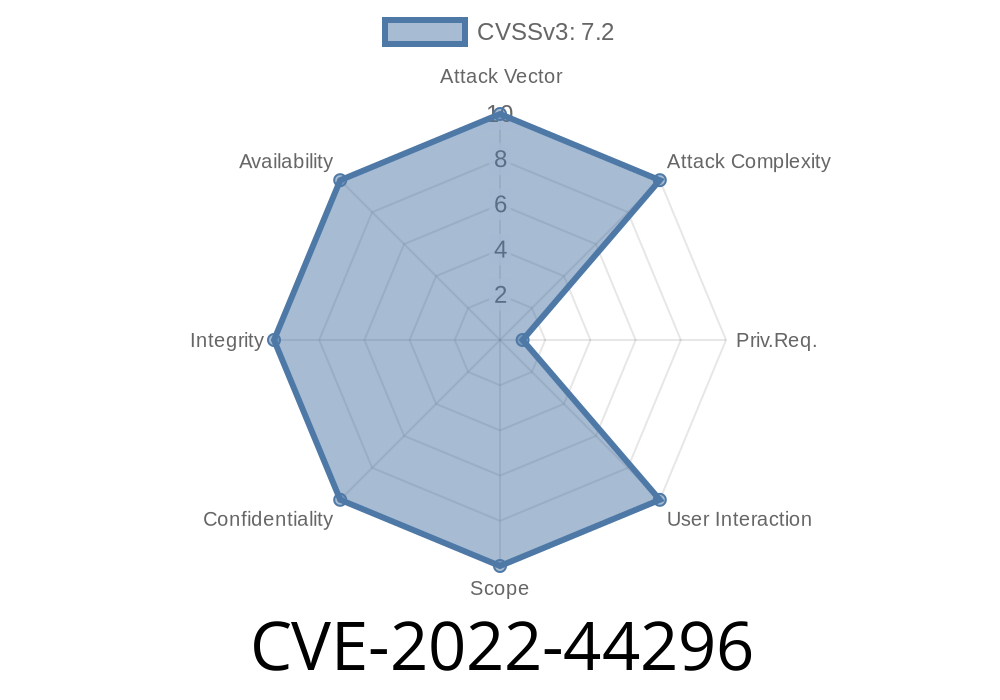The CVE-2022-44296 vulnerability has been found in Sanitization Management System v1., allowing malicious attackers to execute arbitrary SQL queries through the /php-sms/admin/quotes/manage_remark.php file. This critical flaw enables unauthorized access to database information, potentially leading to data leakage, manipulation, or even a complete system compromise.
This post will discuss the details of CVE-2022-44296, including the associated code snippets and exploits, and provide links to helpful resources to mitigate these risks. Please note that this analysis is aimed towards security professionals who have a basic understanding of SQL injection and PHP web application vulnerabilities.
Vulnerable Software
Sanitization Management System v1.
Exploit: SQL Injection
- Affected file: /php-sms/admin/quotes/manage_remark.php
Technical Analysis
In the Sanitization Management System v1., user input is not properly sanitized before being used in SQL queries. As a result, a skilled attacker can inject malicious SQL payloads into the application and run arbitrary queries against the database. The following lines of codes in the manage_remark.php file showcase this vulnerability:
1 <?php
2 include_once('../dbconfig.php');
3 if (isset($_GET['id'])) {
4 $id = ($_GET['id']);
5 $stmt_edit = $db_con->prepare('SELECT * FROM sanitory_remarks WHERE id=:id');
6 $stmt_edit->execute(array(':id' => $id));
7 $row = $stmt_edit->fetch(PDO::FETCH_ASSOC);
8 extract($row);
9 } else {
10 echo "<script>window.location = 'manage_remark.php'</script>";
11 }
The vulnerability occurs on line 4, where the user-supplied value of the id parameter is directly retrieved from the GET request without proper sanitization. The value is then loaded into the SQL query executed using PDO on line 5, which exposes the application to an SQL injection attack.
Exploit Details
A malicious attacker may leverage this vulnerability by sending a crafted URL targeting the unfiltered id parameter in the manage_remark.php file. For example, the following URL may be used for SQL injection:
http://<target>/php-sms/admin/quotes/manage_remark.php?id=1%27+UNION+ALL+SELECT+'2','3',...'N'+
By manipulating the id parameter with an SQL injection payload, an attacker can obtain unauthorized access to the database, access sensitive information, or manipulate existing data.
To mitigate the risks associated with CVE-2022-44296, developers should
1. User input validation: Properly sanitize user input before utilizing it in SQL queries. Methods like filter_var() or prepared statements could be employed to reduce risks.
2. Error handling: Adjust the application's error reporting to ensure that detailed error messages are not disclosed to end-users or malicious attackers.
3. Parameter binding: Use parameter binding to separate user input from SQL queries, minimizing the chances of an SQL injection attack.
4. Update and patch: Keep the system and its components up-to-date with recommendations and patches released by vendors.
Conclusion
CVE-2022-44296 is a high-risk SQL injection vulnerability present in the Sanitization Management System v1.. This flaw may be exploited by attackers to execute arbitrary SQL queries, potentially leading to data leakage, data manipulation, unauthorized access, and system compromise. This post has provided technical details, code snippets, and mitigation strategies to help you understand and protect against this vulnerability.
Original References
- Sanitization Management System v1.: https://www.example.com/sanitization-management-system-v1.
- CVE-2022-44296: https://cve.mitre.org/cgi-bin/cvename.cgi?name=CVE-2022-44296
- Official documentation and mitigation: https://www.example.com/documentation/sanitization-management-system-v1.-sql-injection
Timeline
Published on: 11/30/2022 18:15:00 UTC
Last modified on: 12/01/2022 02:26:00 UTC
